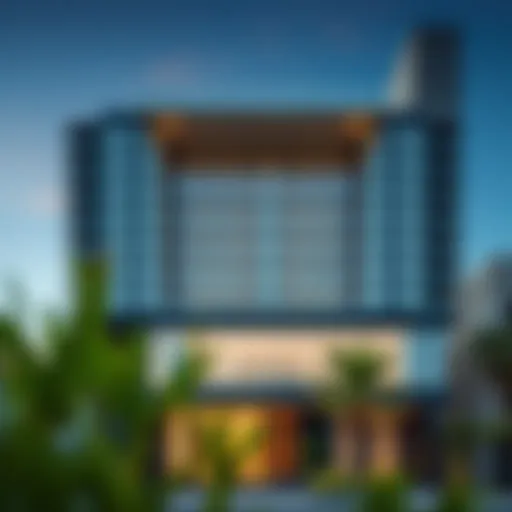Discovering Dubai Metro Zones: A Detailed Overview
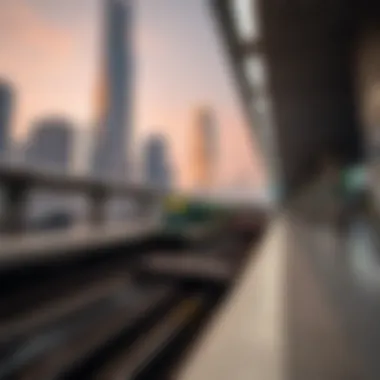
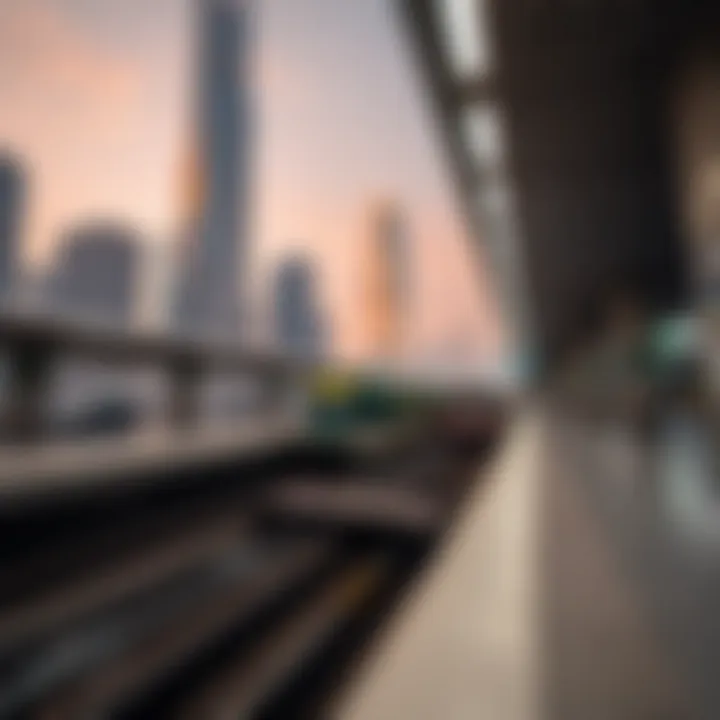
Intro
Navigating the kaleidoscope of Dubai's urban landscape is no small feat. With its sprawling development and intricate transportation networks, the city paints the picture of a modern metropolis. At the heart of this dynamic city lies the Dubai Metro, which serves as both a lifeline and a catalyst for growth across various zones. Understanding these Metro zones is crucial for anyone involved in Dubai's vibrant property market, particularly investors and analysts looking to identify trends and opportunities.
The Dubai Metro is more than just a transit system; it is a gateway to diverse neighborhoods, each boasting its own flavor, lifestyle, and potential for real estate investment. Whether you are seeking the bustling energy of urban life or the tranquility of suburban environments, the Metro lines connect you to it all. This guide is designed to explore those zones in detail, shining a light on their features, accessibility, and real estate dynamics.
By diving into current market trends and future predictions, you'll gain insights crucial for making informed investment decisions.
Let's embark on this fact-finding mission, elucidating each Metro zone's characteristics, investment opportunities, and what they mean for those looking to make their mark in the property market.
Prologue to Dubai Metro
The Dubai Metro, a marvel of modern transit engineering, has become a focal point in the city’s bustling landscape. The significance of this topic lies not just in its ability to connect various zones but also in how it shapes the lifestyle and economy of those who inhabit the city. As travelers, investors, and residents navigate the urban fabric, understanding this metro system opens a window to the opportunities and lifestyle options that Dubai offers.
First and foremost, the Dubai Metro serves as a lifeline for commuting. Its efficient network provides a seamless way for daily commuters to avoid the chaos of road traffic, translating to reduced travel time and greater productivity. It’s reported that the Metro can handle thousands of passengers daily, which makes it a cornerstone for public transport. Moreover, with the vast expansion plans in place, it is poised to increase its capacity even further.
For those investing in Dubai’s real estate market, the Metro also possesses a significant influence on property values. As we dive into each zone serviced by the Metro, it becomes evident that proximity to a station often elevates property prices. Investors should thus consider the metro’s coverage as a critical factor when assessing potential returns on investment, making it essential knowledge for anyone serious about buying or leasing property.
Additionally, the cultural and recreational gateways unlocked by the Metro cannot be understated. Specific stations are strategically located near shopping centers, cultural hubs, and tourist attractions. This makes the metro not just a means of transport, but also a facilitator of lifestyle—opening up avenues for enjoyment, exploration, and service accessibility.
In summary, the Dubai Metro is more than just a transportation system. It is an essential component that interlinks the many facets of urban life in Dubai, from daily commuting and real estate to recreation and culture. As we explore the subsequent sections, the importance of understanding the Dubai Metro becomes increasingly clear—from the overarching framework of the system to the unique characteristics of each zone it serves.
Overview of the Metro System
The Dubai Metro stands as a shining example of modern urban transport, radically changing the transportation landscape of the city. Within this comprehensive guide, understanding the metro system is paramount. The metro not only facilitates commuting but also shapes the real estate market and influences the lifestyle choices of thousands. Its efficiency and modernity attract investors and residents alike, establishing it as a key player in Dubai's rapid urbanization.
Historical Context
To appreciate the present state of the Dubai Metro, one must delve into its historical beginnings. The concept of a metro system for Dubai emerged in the late 1990s against a backdrop of soaring population growth and increasing congestion on the roads. The government realized that without a comprehensive transport solution, the city faced potential gridlock. In 2005, the Roads and Transport Authority (RTA) kicked off construction, introducing a revolutionary approach to public transport. Today, the metro spans over 75 kilometers, with both the Red and Green lines serving countless neighborhoods across the city. This evolution underscores how visionary infrastructure planning can dramatically influence urban living.
Operational Framework
Diving into the operational framework clarifies how the metro efficiently maintains its services. Utilizing a fully automated system, the Dubai Metro operates without a driver, enhancing punctuality and convenience for passengers. The network connects significant commercial and residential areas, increasing accessibility across Dubai.
Additionally, the metro's operations are seamlessly integrated with a comprehensive ticketing system that allows passengers to use multiple forms of transport with ease. The Nol Card, for example, is a smart card that caters to various transportation modes, ensuring a smooth commuting experience. Safety standards are strictly upheld, with regular maintenance checks and innovations continuously implemented to keep pace with demand and technological advancements.
"The Dubai Metro is not just a mode of transport; it's a lifeline for the city's growth and sustainability."
Overall, the overview of the metro system illustrates its significance as a cornerstone of Dubai's urban infrastructure. Investors and residents alike should consider its impact when evaluating properties and lifestyle choices in the ever-evolving cityscape.
Zones Along the Metro Line
Understanding the zones along the Dubai Metro line serves as the backbone of navigating this sprawling city. Each zone offers distinct opportunities, reflecting the diverse character of Dubai. Whether you’re an investor contemplating property in a growing area, an analyst gauging market trends, or a potential buyer looking for that sweet spot to call home, knowing the essentials about these zones can drastically shape your choices.
Not only do these zones define access to amenities and attractions, but they also influence property values, commute times, and overall lifestyle. The link between metro access and the desirability of living or working nearby cannot be overstated. As such, we delve into each segment to provide insight on not just geographical layout but also its economic, cultural, and social implications.
Red Line Zones
UAE Exchange to Rashidiya
Exploring the UAE Exchange to Rashidiya stretch shines a light on the suburban expansion of Dubai. Spanning several kilometers, this section is essential for those commuting to the heart of Dubai or surrounding emirates.
One of the standout features here is the accessibility it provides to various residential neighborhoods, making it particularly appealing to families. The key characteristic of this route is its balance; it merges the hustle and bustle of urban life with the sanctity of suburban comfort. While property developers have continued to develop new residential projects, investors have begun taking interest in this area looking for returns, knowing that price appreciation is inevitable with ongoing expansion.
However, one must also consider the potential downsides. With the growth, there might be increased congestion during peak hours, leading residents to manage travel time accordingly. Nevertheless, the distinct duality of living near the metro line while being ensconced in suburban charm renders this zone quite popular.
Burj Khalifa/Dubai Mall
The Burj Khalifa/Dubai Mall station is perhaps the crown jewel of the Dubai Metro experience, acting as a gateway to some of the most iconic landmarks in the emirate. Often bustling with visitors, this area embodies luxury and modernity.
The primary aspect that stands out is its commercial allure, drawing both expatriates and tourists. Proximity to world-class dining, shopping, and entertainment facilities makes this zone a sought-after locale for those looking to invest in luxury real estate. The iconic skyline is complemented by a flurry of retail spaces and vibrant nightlife, ensuring that the area remains in demand.


While the pros are plentiful, potential investors and homeowners should remain mindful of the price point. Properties in this region come with a heftier price tag; hence understanding economic viability versus the lifestyle offered here is crucial. Still, for many, the experience of living or working near such landmarks far outweighs the cost.
Business Bay
Transitioning to Business Bay, the buzz of commerce fills the air. Known as Dubai's financial district, this area epitomizes the modern working environment—dynamic, fast-paced, and innovative.
The notable feature of Business Bay is its extensive array of office spaces paired with modern residential options, providing convenience for professionals. The seamless integration of business and living quarters attracts a specific demographic: young professionals and families seeking proximity to work, yet craving a vibrant lifestyle.
However, the advantages come paired with challenges; with increased density, the competition for residential spaces can be fierce. It's crucial for potential buyers to navigate the market carefully to find opportunities that strike a balance between investment potential and quality of life.
Green Line Zones
Etisalat to Al Quoz
Traveling along the Green Line from Etisalat to Al Quoz presents a fascinating look at the evolving landscape of Dubai. This area has transitioned significantly over the years, transforming from industrial use to a vibrant district fostering creativity and innovation.
The draw of Al Quoz lies in its burgeoning art scene and warehouse transformations into trendy studios and cafés, which is a unique flip compared to the more polished sections of Dubai. The key characteristic here is versatility—residents engage in a lively environment filled with artistry, startups, and recreational options.
In terms of investment, this zone may initially appear less appealing due to its unpolished reputation. However, the future potential makes it attractive. As more people seek the authenticity and uniqueness that areas like this offer, prices are expected to appreciate, making it an intriguing option for forward-thinking investors.
Dubai Healthcare City
Dubai Healthcare City symbolizes the emirate's dedication to becoming a healthcare hub in the region. This segment of the metro line serves as a crucial artery for accessing various medical institutions, making it particularly beneficial for healthcare professionals and patients alike.
The notable feature of this area is its vast network of medical facilities, research centers, and wellness services. For potential homebuyers, living here means easy access to premier healthcare, a distinct advantage that raises its desirability.
Still, being centrally located comes at a cost. The influx of healthcare professionals and related businesses can create a bustling atmosphere. While some may find this perfect, others may regard it as unsuitable for serene living. Balancing the vibrancy of living next to a healthcare hub must be weighed keenly by buyers.
Jadaf
The Jadaf station marks a distinct area recognized for its cultural significance and maritime history. Tucked next to the Dubai Creek, this zone provides a connection to not just modern Dubai, but also its rich heritage.
One of the key characteristics of Jadaf is its waterfront allure, with local artisans showcasing traditional crafts and a burgeoning arts community thriving amid the backdrop of history. This area attracts those who yearn for a lifestyle enveloped by culture and creativity.
However, while Jadaf’s charm is undeniable, some potential buyers could be deterred by its distance from the main commercial centers of Dubai. This requires consideration of commute times and lifestyle preferences, but for those valuing culture and community over commercial flash, Jadaf can be a hidden gem.
"Understanding the unique characteristics of these zones is essential for anyone looking to thrive in Dubai's real estate market."
The distinctive personality each zone adds to the tapestry of Dubai’s urban life is invaluable. Whether it’s the allure of luxury, the pulse of business, or the roots of culture, the metro zones provide a lens through which to view the future of city living.
Key Features of Each Zone
Understanding the key features of the various metro zones in Dubai is crutial for anyone looking to get a good grip on the city's dynamic real estate landscape. Each zone is not just a geographical entity but a microcosm of opportunities, culture, and commercial prospects. The unique characteristics of these areas can greatly influence housing prices, investment returns, and daily living experiences.
Real Estate Opportunities
Dubai's metro zones have become hotbeds for real estate investment. With the efficiency of the metro system connecting different areas, properties near stations tend to hold a superior value. Buyers are often drawn to these locales for their accessibility and the potential for lucrative returns.
In the Red Line zone, for instance, areas like Burj Khalifa and the Dubai Mall attract significant interest due to their high footfall and commercial viability.
- Strategic Location: Properties close to metro stations are often in demand, driving up their value.
- Rental Yield Potential: With a steady influx of commuters, renting out properties becomes a lucrative venture. A two-bedroom apartment in Dubai Marina can yield around 6-8% in annual rent, depending on its exact location relative to the metro.
- Development Projects: Numerous projects like Dubai Creek Harbour have sprung up with metro access in mind, promoting a blend of residential and commercial spaces, which boosts property valuation further.
Cultural Significance
Each metro zone offers a unique cultural flavor that can enrich daily life for residents. From art galleries to cultural festivals, these areas provide a rich tapestry of experiences that go beyond mere housing.
For example, Dubai Healthcare City isn't just a medical hub but also houses a significant number of art galleries and wellness centers, making it ideal for those seeking a holistic lifestyle.
- Community Engagement: Many areas focus on community events, like the Dubai Design District, where design and creative industry professionals gather, fostering a sense of community.
- Cultural Festivals: Certain zones, particularly near Downtown Dubai, often serve as venues for events such as the Dubai Shopping Festival, bringing in thousands and showcasing local culture.
- Architectural Diversity: Areas like Jadaf boast a mix of traditional and modern architecture, reflecting the city's historical journey and its forward-looking aspirations.
Commercial Viability
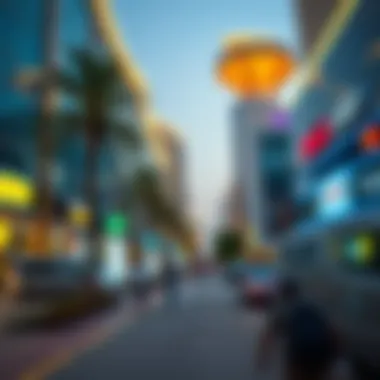
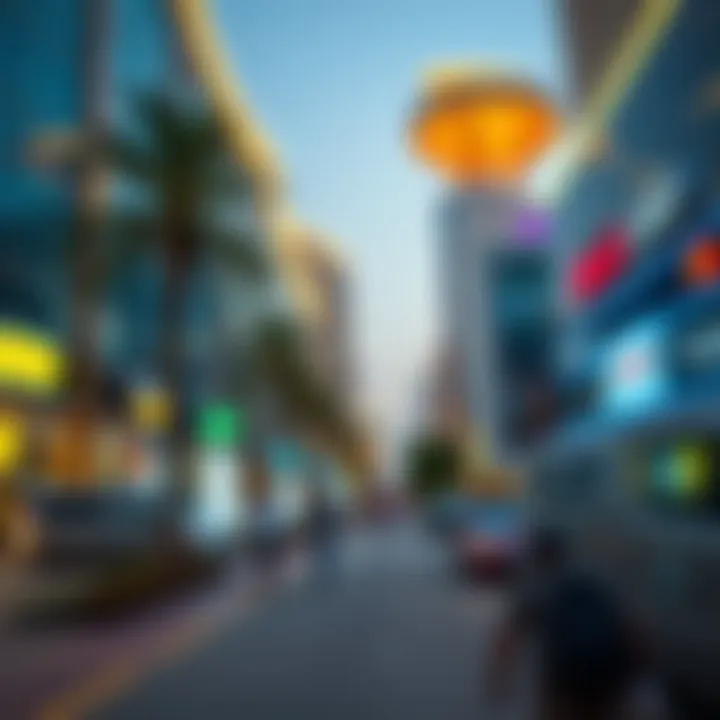
The commercial aspect of each metro zone significantly impacts both business and individual opportunities. Zones such as Business Bay have emerged as key business districts, offering a blend of office spaces, retail outlets, and dining experiences.
- High Foot Traffic: Business zones experience high foot traffic, making them prime spots for retailers looking to cash in on daily commuters. Locations that are just a stone's throw from metro stations can see significant short-term gains in retail performance.
- Diverse Business Ecosystem: The integration of various sectors within these zones provides a diverse business ecosystem. For instance, the Dubai Design District fosters creative entrepreneurs, while the Dubai International Financial Centre attracts finance and investment professionals.
- Investment Attraction: Areas with strong commercial infrastructure are appealing for investors, particularly foreigners, which can lead to increased competition and thus higher property values.
Understanding the importance of these features isn’t just for investors; it can influence lifestyle choices for anyone living in or visiting these vibrant zones of Dubai.
In summary, the key features of each metro zone in Dubai are interlinked with the city’s rapid growth and modernization. Recognizing their unique real estate opportunities, cultural significance, and commercial viability can provide valuable insights for investors, agents, and anyone looking to tap into the bustling energy of this metropolis.
Impact of Metro Zones on Property Prices
Understanding how the Dubai Metro zones affect property prices is crucial for anyone navigating the property market in this dynamic city. The metro, a lifeline for commuters, influences real estate values by shaping accessibility and desirability across neighborhoods. When assessing real estate investments, investors need to comprehend these layers of interconnectivity that the metro offers. Here’s why the impact of metro zones on property prices matters:
Accessibility Drives Demand
In the context of Dubai, ease of transport can make or break property value. Areas with metro access generally see an uptick in demand. Consider a new property in close proximity to the Burj Khalifa/Dubai Mall station—it not only attracts tourists but also professionals who wish to reduce their daily commute. This ease of access raises the allure of living nearby and, in turn, boosts property prices. Locations far from metro links can, conversely, struggle to entice buyers, often leading to stagnant or declining values.
Economic Benefits
Zone expansion often harmonizes with economic growth. When the metro committee announces an extension into a previously underserved area, it frequently signals future economic development. Investors keen on purchasing property might find themselves in the right place at the right time, capturing a market on the brink of expansion. Areas around planned metro stations may experience rapid price escalations due to speculative buying, as investors look to reap potential future rewards.
Consider this: When the Green Line introduced stops in Al Quoz, prices in that area surged. The influx of studios and one-bedroom apartments indicates not just a place to live, but also an opportunity for landlords to capitalize on the growing demand from young professionals.
Lifestyle Changes
Living near a metro station often provides a shift in lifestyle that affects how people perceive property value. For instance, families might seek more spacious homes in quieter neighborhoods while favoring accessibility to the metro. Lifestyle enhancements due to access—like cafes, parks, or shopping centers—can make these zones more appealing, thereby increasing property prices over time. As local amenities blossomed around the metro system, so too did house prices. With conveniences around every corner, the desirability of living in proximity to metro stops can't be overstated.
Market Trends
Real estate market trends in Dubai reflect fluctuations connected to metro accessibility. The marketeer's mantra, 'Location, location, location,' rings true especially here. If a new metro line opens, an area’s property value may follow a bullish trend, yielding significant returns for investors. Keeping an eye on property values before and after metro enhancements can provide crucial information for those looking to invest. Recent patterns have shown how strategic metro location can lead to property values rising more than neighboring areas not served by trains.
Closure
As we analyze the integration of metro zones into Dubai’s real estate landscape, their impact on property prices emerges clear. Metro accessibility acts as a significant catalyst in shaping the value of real estate across the city. Therefore, for investors, agents, and buyers, understanding these dynamics is essential for navigating the thriving yet complex property market in Dubai. The future is bright, and those who can strategically align their investments with metro developments are likely to reap substantial benefits.
"Access to public transportation is not merely a convenience; it's the backbone of property valuation in urban environments."
For more insights on Dubai property investments, check out resources like Dubai Land Department or explore ongoing discussions on reddit.com regarding real estate trends.
In summary, as metro zones continue to evolve, their influence on property prices will remain significant, making it imperative for potential investors to keep a close watch on these developments.
Transportation and Accessibility
Transportation and accessibility stand as critical pillars in understanding the infrastructure of Dubai's Metro Zones. The effectiveness of connectivity in this bustling metropolis not only facilitates daily commutes for residents and tourists but also significantly impacts the real estate landscape. When examining Dubai's Metro system, one must prioritize the role that various transport modes play in shaping the experience of both individuals and businesses within the city.
Integration with Other Transport Modes
The Dubai Metro does not operate in isolation; its efficiency is amplified through seamless integration with other transport modalities. The Metro is strategically connected to buses, taxis, and even water taxis, allowing for a smooth transition between different forms of transportation. For instance, many Metro stations, such as the Union Station, provide direct access to bus services, creating an extensive network that caters to various travel preferences.
- Buses serve as the backbone of public transport, ending at many Metro stops and extending routes deeper into residential and commercial areas. This interconnectedness encourages individuals to make the most of their journeys, whether they're commuting to work or exploring the city's attractions.
- Taxis are widely available near Metro stations, giving riders a chance to complete their journey without the hassle of parking or navigating complex road networks. A quick ride can save time and enhance the convenience of accessing limited or hard-to-reach destinations.
- Additionally, water taxis complement the Metro experience in some zones, especially around the beautiful Dubai Marina. Passengers can effortlessly switch from a railway journey to a scenic boat ride, exemplifying the charm of Dubai's diverse transport options.
Efficient integration paints a picture of a city that values accessibility. As an investor or analyst, understanding this aspect is paramount, particularly when considering the potential growth of property values in areas benefiting from this robust transportation structure.
Commute Patterns
Commuting within Dubai has evolved, driven by the fundamental need for efficiency. The Dubai Metro plays a pivotal role in shaping daily movement patterns among residents, affecting everything from work routines to shopping habits. Most notably, these patterns provide critical insights into how the Metro zones influence property appeal and investment potential.
Examining the statistics reveals a compelling narrative:
- Peak commuting hours: Weekday rush hours typically see a significant spike in Metro usage, with commuters flocking to key stations like Burj Khalifa/Dubai Mall and Business Bay. Understanding these traffic trends allows property investors to assess the livability of areas closely aligned with frequently trafficked routes.
- Long-term commuting habits: The Metro has encouraged longer residential commutes as people now feel comfortable moving further afield. Areas such as Rashidiya, once perceived as distant, have gained popularity among those seeking affordable housing options while still enjoying easy access to the central business districts.
- Seasonal variations: Travel patterns also fluctuate during holidays and events, creating unique opportunities for commercial ventures. For instance, increased Metro usage during major events like the Dubai Shopping Festival can drive a surge in demand for short-term rentals and hospitality services.
In summation, comprehending the intricate tapestry of transportation and accessibility not only enhances our understanding of Dubai's dynamic metro system but also equips investors and analysts with the foresight needed to navigate the property market. Embracing these insights can yield promising opportunities as the city continues to expand and evolve.


"Transportation is the lifeblood of urban dynamics; it shapes our experiences, economy, and lifestyle."
For further insights into the correlation between transportation and urban development, see studies at Wikipedia and Britannica.
Safety and Efficiency of the Metro
When it comes to urban transit systems, the pillars of safety and efficiency are non-negotiable. In Dubai, the Metro has set a benchmark for how modern public transport should operate. The city’s residents, investors, and visitors regard the Metro not merely as a means of transit, but as an integral element that supports an expanding economy and vibrant lifestyle. The safety standards and operational efficiency play a pivotal role in their perception of the Metro system, making it a topic worthy of exploration.
The elegance of the Metro lies not just in its sleek design and extensive coverage but more so in stringent measures put in place to ensure passenger safety while operating with clockwork precision. A deep dive into operational safety standards reveals comprehensive policies designed to guard against accidents, theft, and other threats, ensuring a seamless travel experience.
Operational Safety Standards
Dubai's Metro safety framework intertwines cutting-edge technology with rigorous checks and protocols. The system adheres to international safety regulations, reflecting a commitment to human life. Regular inspections are the school of hard knocks that hold the system to high performance levels. Operators undergo extensive training, ensuring they are adept at handling emergencies and regular operations alike.
- Passenger Safety: Surveillance cameras are ubiquitous throughout the stations and trains. These are not merely ornamental; they serve as the eyes that spot and deter possible disturbances and maintain peace.
- Emergency Protocols: In unforeseen situations, there are well-rehearsed plans in place. Emergency exits, clear signage, and announcements keep passengers informed, ensuring no one is left in the lurch should the need arise.
"In a city as bustling as Dubai, the importance of safety within the Metro cannot be overstated; every measure taken is a reassurance to passengers and stakeholders alike."
Technological Innovations
The quest for efficiency has driven a wave of technological innovations in the Dubai Metro, making it a frontrunner in the realm of urban transit. Automation is not just a buzzword here; it’s a reality that brings about smoother operations and enhanced traveler experiences. From ticketing to real-time information systems, technology plays a crucial role in ensuring the Metro serves the needs of its patrons effectively.
- Automated Train Operation: The driverless trains are a feat of engineering, designed to minimize human error and maximize efficiency. This automation leads to optimal scheduling, reducing wait times significantly.
- Smart Ticketing Systems: Gone are the days of fumbling for change; with contactless payment options, purchasing tickets has transformed into a hassle-free experience, allowing passengers to hop on and off with ease.
- Real-Time Monitoring: A robust network of signals and controls ensures that trains communicate seamlessly. If a glitch arises, operators are equipped to act swiftly, reducing the likelihood of service disruptions.
Future Developments in Metro Zones
The development of metro zones in Dubai is not just about connecting various neighborhoods; it encompasses a broader vision of urban planning and expanding the city's infrastructure. Recognizing future developments is crucial for investors, agents, buyers, and analysts, as these plans can lead to enhanced real estate opportunities and increased accessibility.
One critical consideration is that the growth of metro zones often corresponds with the demand for commercial and residential real estate. As the city expands its metro lines, new areas are opened up for development, which can lead to increased property values in those regions. Investors who keep an eye on these developments are likely to gain significant advantages in Dubai's competitive property market.
Another aspect worth noting is that these future developments are anticipated to significantly enhance the overall quality of life in the city, encouraging more residents and businesses to move into newly serviced areas. It’s not merely about transit; it’s about creating vibrant communities that offer all necessary amenities and conveniences at people’s fingertips.
"The future of metro zones in Dubai reflects a commitment to innovation and sustainability, fundamentally reshaping the urban landscape of the city."
Expansion Plans
The expansion of the Dubai Metro is more than just physical growth; it embodies a commitment to the city's vision for a well-connected urban area. Recent announcements have highlighted plans to extend both the Red and Green lines, thereby reaching previously underserved areas, with newly proposed stops aimed at connecting residential neighborhoods to key commercial hubs.
Some expected benefits of these expansions include:
- Improved Commute Times: A broader network will reduce travel times significantly.
- Increased Foot Traffic: More metro stations mean greater accessibility for businesses, contributing to a boost in local economies.
- Enhanced Connectivity: Connecting distant parts of the city ensures that even the more remote areas benefit from urban advantages.
As these plans unfold, keeping sight of specific new stations will be crucial. Each new station will likely correspond with ongoing plans for residential and commercial developments nearby, creating a ripple effect that potentially elevates property values in the vicinity.
Sustainability Initiatives
In an era where urban environments face substantial challenges regarding sustainability and climate change, Dubai's future metro projects are integrating environmentally sound initiatives. The commitment to sustainability not only enhances public transportation but also adds layers of appeal to real estate development in these zones.
Several notable sustainability initiatives being integrated into future metro zone developments are:
- Energy Efficiency: New metro lines will incorporate energy-efficient trains and technologies, minimizing emissions.
- Eco-Friendly Infrastructure: Construction processes and designs aim to utilize renewable resources and reduce waste, aligning with global sustainability goals.
- Green Spaces: Many proposed metro station areas will include parks and green spaces, promoting a healthier lifestyle for community members.
Investors focusing on properties in these zones should consider the long-term value of sustainability. Areas that prioritize eco-friendly development tend to attract a demographic willing to invest in environmentally responsible living spaces.
Overall, the future developments in the Metro Zones of Dubai promise not only to enhance connectivity but also to provide thoughtful urban planning solutions that will positively impact the living and investment landscape of the city.
Closure
In summarizing the intricate web of opportunities within Dubai's metro zones, it's clear that these areas are much more than mere transit points; they are vibrant ecosystems with significant impact on the city’s economy and lifestyle choices. Understanding these metro zones allows investors, agents, buyers, and analysts to make informed decisions that can ultimately shape their experience in Dubai's dynamic real estate market.
The unique elements that define each zone—ranging from upscale commercial hubs to tranquil residential neighborhoods—offer a spectrum of benefits. For prospective investors, familiarizing oneself with the nuances of these zones can make or break an investment venture. Property prices, influenced by accessibility and nearby amenities, fluctuate dramatically across different zones. Therefore, the insights gleaned from this article are invaluable in discerning the nuances of purchasing and leasing in these areas.
Moreover, the metro lines not only enhance connectivity but also play a pivotal role in urban planning and sustainability initiatives. As officials increasingly prioritize green policies and infrastructure improvements, potential buyers should remain attuned to these trends. The Dubai Metro serves as a prime example of forward-thinking public transport, thus fostering an ideal environment for both residential and commercial investments.
It’s also important to consider lifestyle factors that vary from zone to zone. Each locale serves distinct demographics, with offerings that cater to the unique preferences of families, singles, and tourists alike. Whether one values proximity to bustling shopping centers, cultural venues, or quiet parks, the diverse landscape of Dubai’s metro zones promises something for everyone.
In real estate, not knowing your location is like throwing darts blindfolded; you might hit the target, but more often than not, you’ll miss the mark.
This article lays the groundwork for continued exploration into Dubai's metro zones, suggesting that ongoing analysis will yield timely insights into future developments, pricing shifts, and the area's growth trajectory. As Dubai progresses towards becoming a global hub, staying updated on the nuances within these metro zones will certainly provide an edge in the competitive market.









